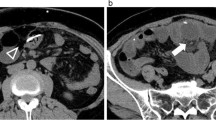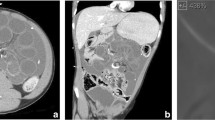Abstract
Background
Significant constipation in patients with shunt-dependent hydrocephalus may often be enough to bring a subclinical shunt malfunction to clinical attention or even to be the cause of temporary distal peritoneal shunt malfunction. The treatment of the constipation may address the symptomatic shunt dysfunction so as to avoid operative intervention. The pathogenesis of distal shunt malfunction and its management in such a situation are discussed, and the relevant literature is briefly reviewed.
Case report
A 16-year-old young boy had shunt-dependent hydrocephalus secondary to prematurity and intraventricular hemorrhage at birth. He was chronic flaccid paraplegic and had a neurogenic bladder and bowel involvement. He presented with acute dull aching intermittent headaches, nausea, and constipation of short duration. There was no underlying shunt infection. CT brain showed dilated lateral ventricles. Shunt survey revealed a convoluted course and kink in the distal peritoneal catheter. After administration of a bowel enema, the headaches and nausea resolved over the next few hours, and the posttreatment CT showed significant decrease in ventricular size.
Conclusion
Chronic constipation is an important predisposing factor for distal malfunction in shunt-dependent hydrocephalus and should be ascertained in evaluation of a ventriculoperitoneal shunt malfunction. Appropriate treatment of significant constipation can relieve shunt malfunction and reestablish cerebrospinal fluid circulation. A shunt exploration can be avoided in such a situation. A close neurological monitoring of the patient is essential during the course of treatment. An interdisciplinary approach between concerned medical specialities and enhanced awareness is mandatory to ensure appropriate bowel management.




Similar content being viewed by others
References
Agha FP, Amendola MA, Shirazi KK, Amendola BE, Chandler WF (1983) Abdominal complications of ventriculoperitoneal shunts with emphasis on the role of imaging methods. Surg Gynecol Obstet 156:473–478
Arnell K, Olsen L (2004) Distal catheter obstruction from non-infectious cause in ventriculo-peritoneal shunted children. Eur J Pediatr Surg 14:245–249
Barnes NP, Jones SJ, Hayward RD, Harkness WJ, Thompson D (2002) Ventriculoperitoneal shunt block: what are the best predictive clinical indicators? Arch Dis Child 87:198–201
Cozzens JW, Chandler JP (1997) Increased risk of distal ventriculoperitoneal shunt obstruction associated with slit valves or distal slits in the peritoneal catheter. J Neurosurg 87:682–686
Cusimano MD, Meffe FM, Gentili F, Sermer M (1990) Ventriculoperitoneal shunt malfunction during pregnancy. Neurosurgery 27:969–971
Drake JM, Sainte-Rose C (1995) Shunt complications. In: Drake JM, Sainte-Rose C (eds) The shunt book. Blackwell, Cambridge, Massachusetts, pp 136–137
Hussain NS, Wang PP, James C, Carson BS, Avellino AM (2005) Distal ventriculoperitoneal shunt failure caused by silicone allergy. Case report. J Neurosurg 102:536–539
Lazareff JA, Peacock W, Holly L, Ver Halen J, Wong A, Olmstead C (1998) Multiple shunt failures: an analysis of relevant factors. Childs Nerv Syst 14:271–275
Lee TT, Uribe J, Ragheb J, Morrison G, Jagid JR (1999) Unique clinical presentation of pediatric shunt malfunction. Pediatr Neurosurg 30:122–126
Rekate HL (1991–92) Shunt revision: complications and their prevention. Pediatr Neurosurg 17:155–162
Sainte-Rose C, Piatt JH, Renier D, Pierre-Kahn A, Hirsch JF, Hoffman HJ, Humphreys RP, Hendrick EB (1991–92) Mechanical complications in shunts. Pediatr Neurosurg 17:2–9
Sasagawa Y, Sasaki T, Fuji T, Akai T, Iizuka H (2006) Ventriculoperitoneal shunt malfunction due to pregnancy. No Shinkei Geka 34:181–187 (in Japanese)
Tubbs RS, Wellons JC 3rd, Blount JP, Oakes WJ (2005) Transient ventriculoperitoneal shunt dysfunction in children with myelodysplasia and urinary bladder infection. Report of three cases. J Neurosurg 102:221–223
Watkins L, Hayward R, Andar U, Harkness W (1994) The diagnosis of blocked cerebrospinal fluid shunts: a prospective study of referral to a paediatric neurosurgical unit. Childs Nerv Syst 10:87–90
Author information
Authors and Affiliations
Corresponding author
Rights and permissions
About this article
Cite this article
Muzumdar, D., Ventureyra, E.C.G. Transient ventriculoperitoneal shunt malfunction after chronic constipation: case report and review of literature. Childs Nerv Syst 23, 455–458 (2007). https://doi.org/10.1007/s00381-006-0232-2
Received:
Revised:
Published:
Issue Date:
DOI: https://doi.org/10.1007/s00381-006-0232-2




